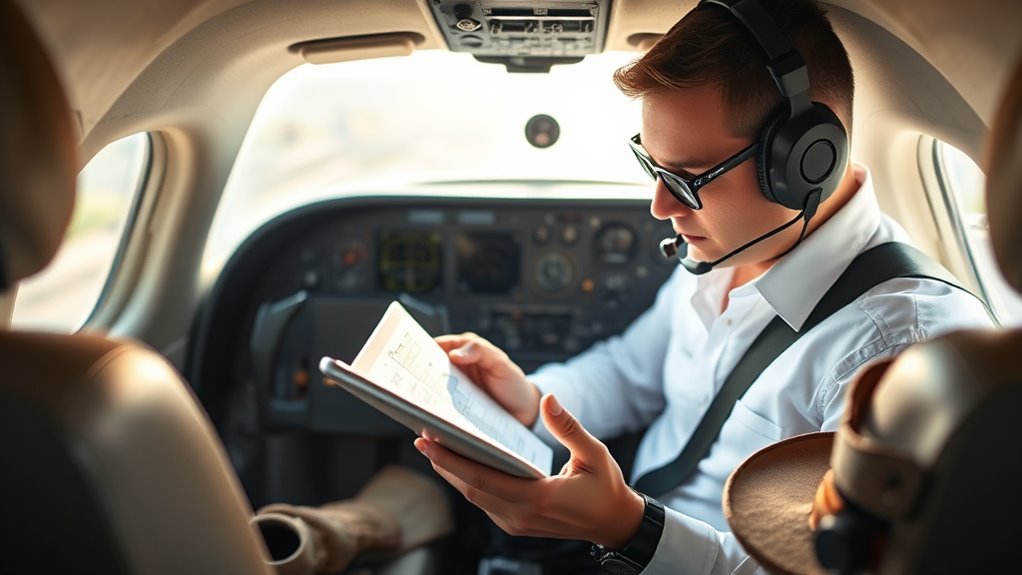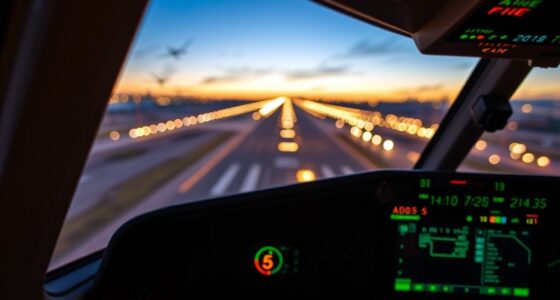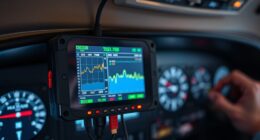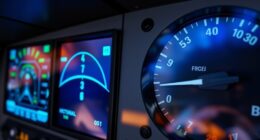Starting your flying season safely begins with a thorough pre-flight self-briefing. You review weather reports, radar images, and flight plans to identify hazards like turbulence or thunderstorms. Familiarize yourself with emergency procedures and visualize responses to unexpected situations. Confirm your personal and aircraft equipment are ready and functional. Engaging actively in this process helps build confidence and reduces hesitation. If you want to know more about how to prepare effectively, continue exploring these essential steps.
Key Takeaways
- Conduct thorough review of weather reports, radar images, and forecasts to identify hazards and adjust flight plans accordingly.
- Familiarize yourself with aircraft emergency procedures and visualize responses to various emergency scenarios.
- Actively engage with checklists and mentally rehearse responses to potential in-flight issues.
- Ensure all personal documents, navigation tools, and safety equipment are current, accessible, and functional.
- Assess your physical and mental readiness, confirming overall preparedness for safe flying during the season.

Have you ever wondered how pilots stay prepared for every flight? It all begins with a thorough pre-flight self-briefing. This process isn’t just about checking your aircraft’s maintenance logs or reviewing your flight plan; it’s about actively preparing your mind for the upcoming journey. One of the most critical steps in this preparation is conducting a detailed weather briefing. You need to know what conditions to expect along your route, at your departure point, and at your destination. By reviewing current weather reports, forecasts, and radar images, you can identify potential hazards like turbulence, wind shear, thunderstorms, or low visibility. This knowledge allows you to adjust your flight plan accordingly, whether that means rescheduling, choosing an alternate route, or preparing for different in-flight procedures.
Alongside weather, understanding emergency procedures is essential for your safety and confidence. During your self-briefing, familiarize yourself with the specific emergency protocols relevant to your aircraft and the route you’re flying. This includes knowing how to handle engine failures, electrical system malfunctions, or cabin depressurization. Visualize each step you’d take in an emergency, from executing emergency landings to activating fire suppression systems. Reinforcing these procedures in your mind helps you react swiftly and calmly if an unexpected situation arises. It’s also wise to review the location of emergency equipment on board and ensure all safety gear is accessible and in working order.
Familiarize yourself with emergency protocols and visualize your response to ensure swift, calm reactions in unexpected situations.
Your self-briefing should be an active, deliberate process. Don’t just passively read through checklists; engage with the information. Think about potential scenarios, ask yourself questions, and mentally rehearse your responses. This mental simulation enhances your readiness and reduces hesitation during actual emergencies. Remember, even if you’re an experienced pilot, conditions can change rapidly, and new challenges can emerge. Staying current on weather updates and emergency procedures ensures you’re not caught off guard. Additionally, staying informed about juice cleansing and detox strategies can help you maintain your energy levels and mental clarity during demanding flights or busy schedules.
Finally, your pre-flight self-briefing should be a review of your personal readiness. Check your physical and mental state—are you alert, rested, and focused? Confirm that all your documentation, maps, and navigation tools are up to date. When you approach each flight with a thorough mental preparedness routine, you set the stage for a safe and confident journey. A well-executed self-briefing isn’t just a formality; it’s your first line of defense in ensuring a safe start to the flying season.
Frequently Asked Questions
How Often Should Pre-Flight Self-Briefings Be Updated?
You should update your pre-flight self-briefings before every flight. Make sure to review the latest weather updates and verify your checklist accuracy each time. Conditions can change rapidly, so staying current guarantees you’re prepared for any surprises. Regular updates help you identify new hazards, confirm your procedures, and maintain safety standards. Never rely on outdated information; always refresh your briefing to fly confidently and responsibly.
Are There Digital Tools to Assist With Self-Briefings?
Yes, there are digital apps that help with self-briefings and flight planning. You can use these tools to access real-time weather updates, checklists, and safety information, making your pre-flight preparations more efficient. These digital apps streamline your process, ensuring you cover all essential points quickly. Incorporating them into your routine helps you stay organized, confident, and ready for a safe flying season.
What Should I Do if I Find Conflicting Information?
If you find conflicting sources during your self-briefing, don’t ignore it. First, verify the information using trusted verification methods like cross-referencing official aviation resources or contacting experienced pilots. Seek clarification from reliable sources, such as your flight operations or safety team. Always prioritize safety by confirming any conflicting information before proceeding. This ensures you’re working with accurate data, reducing risks during your flight.
How Can I Ensure My Self-Briefing Is Comprehensive?
To guarantee your self-briefing is thorough, focus on detailed flight planning by reviewing routes, weather, and aircraft data. Incorporate risk management strategies by identifying potential hazards and mitigation measures. Double-check all information for accuracy, consult current resources, and consider possible emergencies. Stay organized and systematic, and don’t skip any steps—this approach helps you cover all critical aspects for a safe, informed flight.
Do Self-Briefings Replace Professional Weather Briefings?
You might think your self-briefing can replace professional weather briefings, but it can’t. Relying solely on your own research undermines pilot independence and risks missing critical updates. Professional weather briefings provide unmatched weather accuracy, essential for safe flights. Never underestimate the importance of expert insights—your self-briefing should complement, not substitute, official briefings to ensure safety and informed decision-making every time you fly.
Conclusion
By taking a few minutes for a pre-flight self-briefing, you considerably boost your safety and confidence. Remember, studies show that pilots who perform thorough pre-flight checks are 30% less likely to encounter in-flight issues. So, before you take off, pause, review your plan, and make sure everything’s in order. A quick self-briefing might just be the difference between a smooth flight and an unexpected emergency. Stay safe, stay prepared, and enjoy your flying season!









